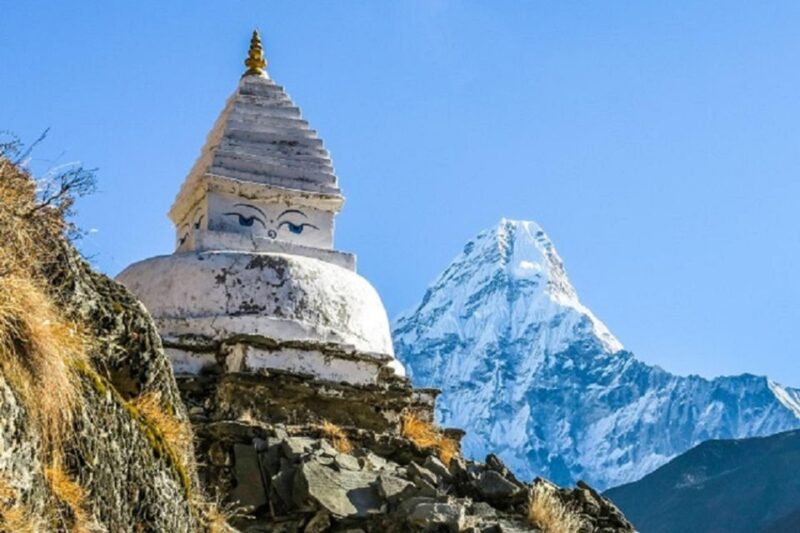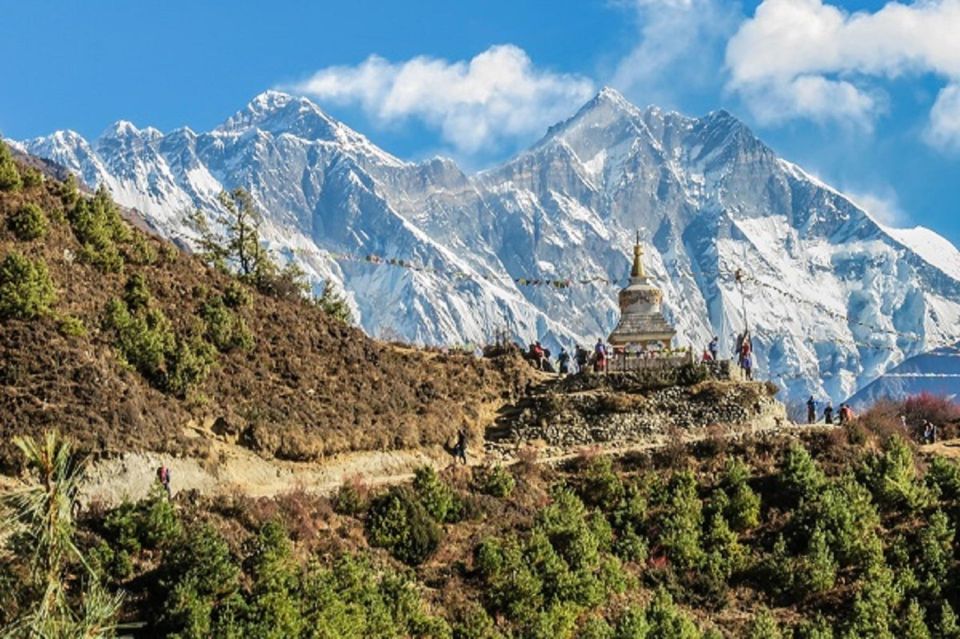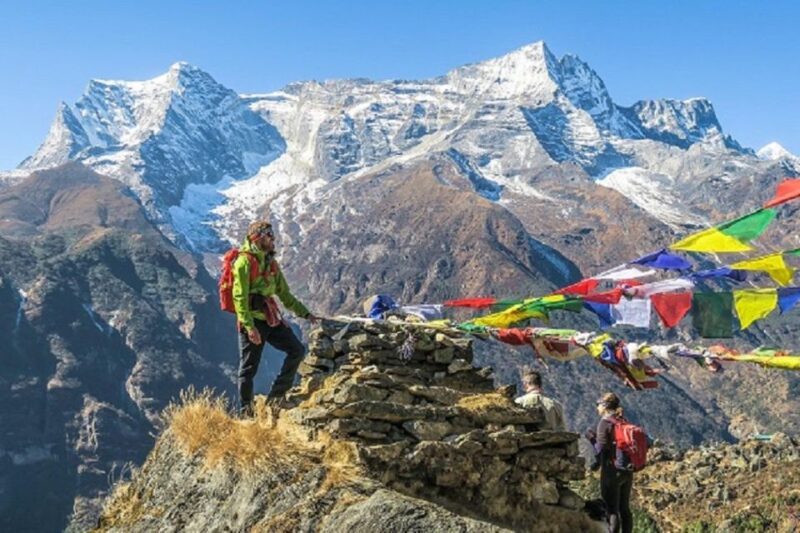When considering a short trek to Everest Base Camp, many discover it’s more than just a hike; it’s an opportunity to witness some of nature’s most stunning landscapes while respecting the rich Sherpa culture. Over nine days, trekkers navigate challenging terrains and experience the thrill of reaching 5,364 meters. Yet, despite the allure of the mountains, there are essential factors to keep in mind for a successful journey. What should trekkers pack, and how can they best acclimatize to the altitude? These questions are crucial for ensuring a fulfilling adventure.
Key Points

- The trek to Everest Base Camp takes approximately 9 days, making it a manageable option for short trekking trips.
- The journey covers around 130 kilometers round trip, providing a fulfilling yet condensed experience of the Himalayas.
- Acclimatization days in Namche Bazaar and Dingboche help trekkers adjust to high altitudes effectively.
- Stunning views of Everest, Lhotse, and other peaks enhance the short trek’s scenic appeal.
- Cultural immersion with the Sherpa community adds a unique dimension to the trekking experience.
Trek Overview

The Everest Base Camp Trek offers adventurers a thrilling 9-day journey to one of the world’s most iconic landscapes, reaching an elevation of 5,364 meters (17,600 ft) amidst breathtaking Himalayan vistas.
Covering approximately 130 kilometers round trip from Lukla, trekkers experience not just stunning views of Everest, Lhotse, and Nuptse, but also the unique culture of the Sherpa people.
The trek intertwines physical challenge with rich cultural experiences, allowing hikers to engage with local traditions and hospitality.
Along the way, they’ll encounter the majestic Khumbu Glacier and the legendary Khumbu Icefall, making it a perfect blend of adventure and awe-inspiring scenery.
It’s an unforgettable journey that’s both physically demanding and culturally enriching.
You can also read our reviews of more hiking tours in Pheriche
Itinerary Breakdown
Exploring the detailed itinerary of the Everest Base Camp Trek reveals a well-structured plan that guides trekkers through breathtaking landscapes and cultural encounters over nine unforgettable days.
The journey kicks off with a flight to Lukla, followed by a trek to Phakding.
Days two and four focus on acclimatization in Namche Bazaar and Dingboche, ensuring trekkers adjust to the altitude.
Days three and five lead to scenic spots like Tengboche and Lobuche, while day six is the highlight—reaching Everest Base Camp.
On day seven, trekkers rise early for a stunning sunrise at Kala Patthar.
The trek wraps up with a return to Lukla, offering a balanced mix of adventure and culture throughout the journey.
Inclusions and Exclusions

When planning an Everest Base Camp Trek, it’s essential to know what’s included and what’s not in the package to avoid any surprises along the way. Here’s a quick breakdown:
| Inclusions | Exclusions |
|---|---|
| Kathmandu to Lukla flight ticket | Personal adventure gear and equipment |
| Licensed English-speaking guide | Drinks, laundry, communication, and personal expenses |
| Twin-sharing accommodation in tea houses | Tips for guides and porters |
| Meals: Breakfast, Lunch, Dinner | Entry fees for local monasteries, museums, monuments |
| Porter support for bag carrying | Anything not mentioned in inclusions |
Understanding these details helps trekkers prepare better and ensures a smoother adventure in the stunning Himalayas.
Experience Highlights
Trekking to Everest Base Camp offers unforgettable vistas of the majestic Himalayas, including breathtaking views of the legendary Khumbu Icefall.
Adventurers will navigate thrilling trails that present high-altitude challenges, pushing their limits while soaking in stunning landscapes.
The trek also provides a unique culture, allowing trekkers to connect with the warm and welcoming Sherpa community.
Along the way, they’ll have the chance to observe mountaineers at Everest Base Camp, gaining insight into the world of high-altitude climbing.
For those seeking even more awe, an optional side trip to Kala Patthar rewards hikers with spectacular sunrise views over the surrounding peaks.
This journey promises not just physical challenge, but a deep appreciation for nature and culture.
More Great Tours NearbyBooking Information
Booking the Everest Base Camp Trek is straightforward, with options available that cater to different budgets and preferences. Trekking agencies typically offer packages that include accommodations, guides, and meals, making it easy for travelers to plan their adventure.
Here’s a quick overview of booking options:
| Package Type | Price (Kč) | Cancellation Policy |
|---|---|---|
| Budget | 31,347 | Free cancellation up to 24 hours |
| Standard | 45,000 | Full refund for cancellations |
| Luxury | 70,000 | Flexible booking, pay later |
| Group Discounts | Varies | Negotiable based on group size |
| Custom Packages | Customized pricing | Tailored cancellation terms |
With flexible booking options and transparent pricing, trekkers can secure their dream adventure with ease!
Preparation Tips
With the right preparation, trekkers can enhance their experience on the Everest Base Camp Trek and tackle the challenges of high-altitude hiking more effectively. Here are four essential tips:
-
Train in Advance: Start a fitness regimen focusing on endurance and strength to prepare your body for the trek’s demands.
-
Gear Up Properly: Invest in quality trekking gear, including sturdy boots, layered clothing, and a good sleeping bag.
-
Stay Hydrated: Drink plenty of water during the trek to combat altitude sickness and keep energy levels up.
-
Acclimatize: Take acclimatization days seriously, allowing your body to adjust to the altitude gradually.
What to Expect
Trekkers can look forward to breathtaking landscapes, vibrant Sherpa culture, and the exhilarating challenge of reaching Everest Base Camp at 5,364 meters. The journey promises stunning views of towering peaks, including Everest itself, and the chance to experience the unique traditions of the Sherpa people.
Here’s a quick overview of what to expect during the trek:
| Aspect | Details | Tips |
|---|---|---|
| Altitude | 5,364 meters at Base Camp | Acclimatize properly |
| Trek Duration | 9 days | Stay hydrated |
| Cultural Experience | Sherpa hospitality | Engage with locals |
| Scenery | Panoramic mountain views | Bring a camera |
| Difficulty | Moderate to challenging | Prepare for altitude |
With proper preparation, trekkers will surely have an unforgettable experience!
Cultural Insights
The Everest Base Camp Trek offers a unique opportunity to take in the rich Sherpa culture, showcasing their hospitality, traditions, and deep-rooted connection to the majestic mountains.
Trekkers often find themselves enchanted by various cultural aspects, including:
-
Warm Hospitality: Sherpas welcome visitors with open arms, offering tea and sharing stories.
-
Traditional Festivals: Experience colorful festivals like Losar, celebrating the New Year with music and dance.
-
Buddhist Practices: Visit monasteries and learn about the spiritual significance of Buddhism in daily life.
-
Local Cuisine: Savor traditional dishes such as dal bhat and momos, reflecting the region’s flavors.
Engaging with the Sherpa community enriches the trekking experience, creating lasting memories and a deeper understanding of their way of life.
Frequently Asked Questions
What Is the Best Time to Trek to Everest Base Camp?
The best time to trek to Everest Base Camp is typically spring (March to May) and autumn (September to November). During these months, hikers enjoy clearer skies, milder temperatures, and vibrant landscapes, enhancing their overall experience.
How Physically Fit Do I Need to Be for This Trek?
For this trek, they should be moderately fit. Regular walking or hiking helps build endurance. It’s vital to acclimatize properly and listen to their body, ensuring they stay hydrated and rested throughout the journey.
Are There Age Restrictions for Participants on the Trek?
The trek doesn’t impose strict age limits, but participants should be at least 12 years old. Younger trekkers need parental supervision. Everyone’s encouraged to assess their fitness and readiness for high-altitude challenges before joining.
What Emergency Services Are Available During the Trek?
During the trek, there’s access to basic medical services, including first aid from guides. For serious emergencies, helicopter evacuation can be arranged, ensuring trekkers’ safety in challenging high-altitude conditions.
Can I Bring My Pet on the Trek?
He can’t bring his pet on the trek. The rugged terrain and altitude pose challenges for animals, and most trekking companies have strict policies against pets, prioritizing safety and comfort for all trekkers.
Recap
To sum it up, the Everest Base Camp trek offers an unforgettable adventure for those eager to explore the Himalayas without a lengthy commitment.
With stunning landscapes, rich Sherpa culture, and the thrill of reaching high altitudes, it’s an experience like no other.
Whether you’re a seasoned trekker or a first-timer, this journey promises to leave lasting memories.
So, lace up your boots and get ready to embrace the beauty and challenges that await on this iconic trek!
You can check availability for your dates here:More Hiking & Trekking Tours in Pheriche
More Tour Reviews in Pheriche
Not for you? Here's more nearby things to do in Pheriche we have reviewed
- Everest Base Camp Trek
- Kathmandu: 20 Day Everest Base Camp Trek with Kalapatthar
- Kathmandu : 14 -Day Everest Base Camp with Kala Patthar Trek
- Everest base camp trek 12 days
- Lukla: 11-Day Everest Base Camp Trek from Lukla with Guide
- Nepal: Everest Base Camp with Kalapathar Trek
- From Kathmandu: 12 – Day Everest Base Camp Guided Trek
- Kathmandu: Everest Helicopter Tour with Syangboche Landing
- From Kathmandu: 11- Day Everest Base Camp Trek with Guide
- From Pokhara: 11-Day Budget Everest Base Camp Trek
- Kathmandu : Budget 15-Day Everest Base Camp Trek /2025
- From Lukla: 18-Day Everest Base Camp and Gokyo Lakes Trek
